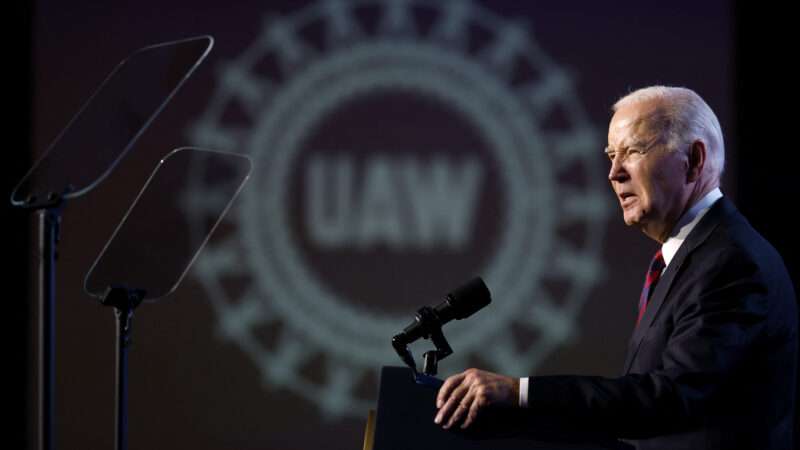
Unions are said to be having a moment. The story goes something like this: Helped by a presidential administration that touts itself as the "most pro-union in history," labor unions—after decades of decline—are winning big victories against anti-union corporations and extracting impressive concessions for their workers. But is it all true?
There has certainly been a lot of union activity. Last year we witnessed a significant increase in strikes and threats of strikes. According to the Bureau of Labor Statistics, the country lost 16.6 million labor days to work stoppages last year. You have to go all the way back to 2000 to find this level of union disturbance.
In addition, the United Auto Workers (UAW) reached an agreement with Ford that included wage hikes of 25 percent. Similar agreements with Stellantis and General Motors followed. Other unions won contract gains at large employers such as UPS and Hollywood TV and film studios. Then there was the much celebrated UAW victory in a representation election at Volkswagen in Tennessee and progress made at some Starbucks stores.
All the same, talk of a union renaissance might be much ado about nothing. Union membership as a share of wage and salary workers has declined steadily from 28.3 percent in 1967 to an all-time low of 10 percent in 2023. Although the absolute number of union workers has recently risen, it hasn't kept up with the growth of the total number of American workers.
National Review's Dominic Pino has been following unions comprehensively. He never forgets to report both their wins and their losses. For instance, workers at a unionized Nissan facility in Somerset, New Jersey, are in the process of decertifying from the UAW. The same happened at various non-Starbucks coffee shops.
These events are in line with the overall trend for UAW, Pino notes, as "membership declined last year to 370,000. It was nearly 400,000 in 2020, and it peaked at 1.5 million in 1970." To be fair to the labor movement, part of this decline could be because UAW bosses have been pretty corrupt. For instance, National Review reported that "in December 2020, the UAW reached a settlement with the Department of Justice after a yearslong fraud and corruption investigation. More than a dozen top union officials, including two former presidents, were convicted of crimes for embezzlement of workers' dues."
It could also be that unions aren't so much about fighting for the cause of blue collar workers as they used to be. Indeed, 49 percent of union members worked for the government in 2023. Thirty-three percent of public sector employees are in unions, as opposed to just 6 percent of the private sector. In the case of UAW, about 100,000 members work in higher education, including graduate student workers statistically likely to go on to non–blue collar jobs.
I believe public sector unions shouldn't exist. Taxpayers—the ones paying the bills when government unions successfully negotiate pay and benefits hikes—are not adequately represented at the negotiation table. In fact, with their political donations, public sector unions help decide who sits on the other end of that negotiating table.
By contrast, private unions have every right to exist, but this doesn't mean they're a good thing on net for workers. A September 2023 National Bureau of Economic Research paper looked at what a unionized workforce does to incentives and investment. While unionized plants pay higher wages and benefits than do nonunionized ones, they also "experience higher rates of closure, reduced investment, and slower employment growth." In other words, your unionized job might pay more, as long as it doesn't go away—and good luck finding another like it. The result holds also for partially unionized plants.
Introducing more competition to the private sector union business model could help. For that, my colleague Liya Palagashvili suggests ending the exclusive-representation clause that "provides government-granted monopoly status to a union supported by 51 percent of an employer's workers, giving it the sole authority to negotiate. This means that if some workers want a different union—for example a newer one that might raise the bar in terms of what it can offer—they are out of luck." Today, these workers aren't allowed to engage in any negotiations with their employers, and they still have to pay the original union's fees.
The bottom line is that unions aren't really going through a renaissance. All things considered, their failure is most workers' gain.
COPYRIGHT 2024 CREATORS.COM.
The post No, Unions Aren't Having a Resurgence—and That's Good for Workers appeared first on Reason.com.







